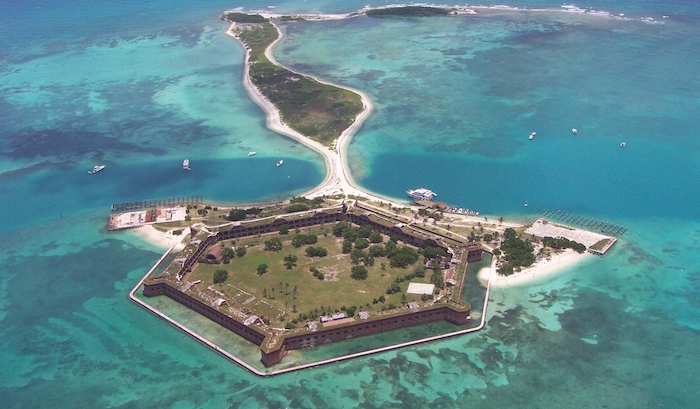Once a month here on the Molten Sulfur Blog, I run content taken from our book Archive: Historical People, Places, and Events for RPGs. This post is one of eighty entries in Archive, each more gameable than the last!

Fort Jefferson
Remote Tropical Fortress
The Dry Tortugas are a group of seven small islands 70 miles off Key West, Florida. The islands are popular for their pristine waters and fantastic snorkeling opportunities, but they also hold a marvelous relic of United States history. Erected on one of the islands is the massive Fort Jefferson, the largest coastal fort in the country. When construction on the fort began in 1846, it was intended to serve as an advance post for ships patrolling the Gulf of Mexico and the Florida Straits.
Fort Jefferson enjoys a colorful, albeit quiet, history. Construction took decades. The trouble with building such a large fort on a relatively remote island is moving the building materials. Countless bricks had to be delivered by boat. Construction was so arduous that, even after 30 years of work, Fort Jefferson was never fully completed. By the time the fort was ‘ready enough’, improvements in military technology had rendered it obsolete. Stone walls were little protection against the new rifled cannons. Instead, the fort was used as a military prison during the Civil War. Most of the prisoners at Fort Jefferson were Union deserters, plus a few robbers. One of the more famous prisoners was Dr. Samuel Mudd, a conspirator in the assassination of President Abraham Lincoln. While imprisoned, Mudd helped treat an outbreak of yellow fever at the fort, and was rewarded with a pardon by President Andrew Johnson. By 1888, after the fort was battered by several hurricanes, it was handed over to the Marine Hospital Service, which used it as a quarantine station. In 1935, it was designated a national monument, and in 1992, the Dry Tortugas were designated a national park.
Today, you can explore the old fort and enjoy its slow deterioration. Walls of red brick outline the edges of the island. You can look out one window and stare out over the breakwater to the pristine sea beyond, and then walk across the hall to view the lush green island enclosed by the fort. You can explore the living quarters, gunpowder magazines, storehouses, and lighthouse. Chalky white salt crawls up the exposed brick, while some of the inner walls look like new. Some sections of the fort started to sink during construction, threatening to flood the place. In these sections, the second tiers of the fort were strategically left incomplete to limit the its weight and slow subsidence. Fort Jefferson today is silent, lonely, and hot. Worse, the only fresh water comes from the sky and in jugs. There is no spring on these islands, hence the name ‘Dry’ Tortugas.
Fort Jefferson in Play
At your table, Fort Jefferson is probably best as a stopover point on the way to somewhere else. No one lives here permanently if they can help it. A hurricane might force the PCs to hunker down here, waiting out the storm with the crews of a few other small boats. Complications arise when one of the NPCs is found murdered. As the PCs try to solve the mystery, more NPCs vanish, and the survivors turn on each other out of paranoia and desperation. Or maybe the PCs stop at Fort Jefferson to stretch their legs after a few weeks at sea, only to learn that a snorkeler is missing. The park ranger is convinced there’s a killer shark out there, but actually the snorkeler stumbled upon some South American drug smugglers using one of the empty islands of the Dry Tortugas as a handover point. Alternately, the PCs might encounter the ghosts of prisoners who died here. The spirit of a robber might reveal where he hid his loot. Or the tormented shades of Union deserters might demand retribution for being the subjects of horrible clandestine experiments. Perhaps Dr. Mudd wasn’t really a prisoner, but was secretly the warden! Are the ghosts content with revealing the truth? Or do they insist upon taking revenge on Dr. Mudd himself, nevermind that he’s been dead for a hundred years?
–
This post is brought to you by beloved Patreon backer Arthur Brown. Thanks for helping keep the lights on! If you want to help keep this blog going alongside Arthur, head over to the Patreon page – and thank you! (due to an excess of promotion, for this one time only I’m moving this ‘thank you’ to the bottom of the page – Arthur, I hope you can forgive me)






